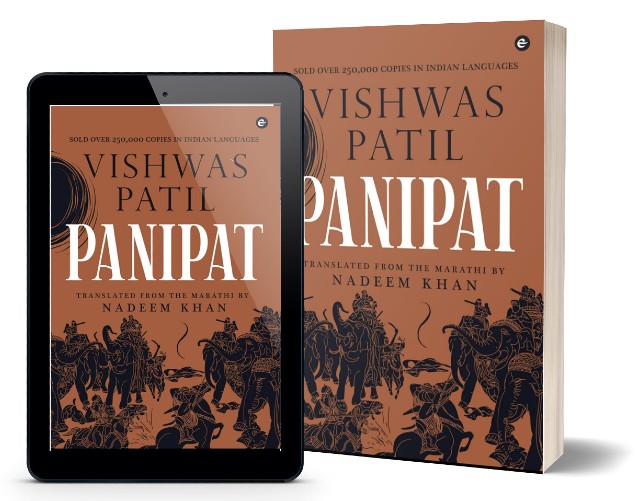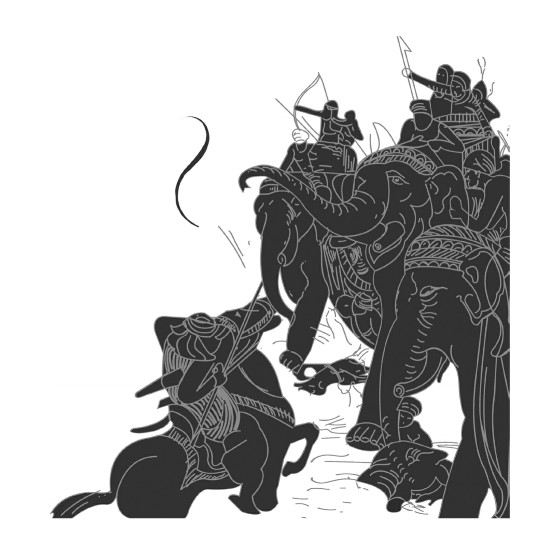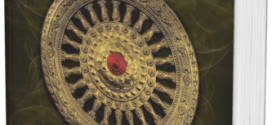Every historical account written after many years of the actual series of incidents happen relies highly on the research material available. Often, even the reference material is found written from the perspective of the author and it is natural and obvious to find it influenced by the political scenario/situation at the time of writing it.
This Is Here In For You
Listen To The Podcast:
If you love to listen to the book review over reading, or if you want to go through it while doing other activity, here is our Podcast of this review article. Do listen, and share your thoughts with us.
Spotify:
YouTube:
It is thus rightly said, “till the tiger learns to write, hunter will be the hero of the story”.
We see a lot of biased and one-sided narrative regarding various historical incidents, so when some scholars and researchers decide to explore them as much neutral or from a different perspective; his/her job becomes more challenging.
Of course, till we got freedom/independence in 1947, the history was written by foreigners, but, since the independence it is our responsibility to explore it in as much “absolute” perspective as much possible. Of course, it is neither to blame someone or shift a blame from someone, but, it is to view the incidents as they happened. And, more importantly learn from them.
The war of Panipat is considered as one of most brutal wars fought in a last few hundred years on Indian soil. As the Marathas lost the war, many authors and historians have avoided exploring it. Vishvash Patil, a Marathi author has decided to explore it to find out the most reliable account of the incidents and document it as a book. He had explored a lot of reference books and material available, and came up with the book – Panipat. It is not only respected as a well-researched account of the war and more importantly the chain of incidents that resulted into the consequences happened; but also is one of the most commercially successful novel/book in an Indian language. It is worth to note that over 250000 copies of the book are sold in Indian languages, and counting. As the original book is in Marathi, we read the English translation of the same, done by Nadeem Khan.
The book can be considered as a historical fiction, in a sense that when researching if the author found some gaps he has to fill it with most logical imagination; and if more than one different perspectives of the same incidents are found, he has to chose the one he thinks the most logical.
| Book Title | : | Panipat |
| Author | : |
Vishvash Patil Translated by: Nadeem Khan |
| Publisher | : | Westland (16 December 2019) |
| # of Pages | : |
650 (Paperback) 7331 KB; 592 (Kindle EBook) |
| # of Chapters | : | 5 |
| Purchase Link(s) | : |
So, we were curious to read the book since very long. Recently, from our team, I got a chance to read it (kindle edition) and here are my personal views for the same.
By the way here are quick links to our reviews for some more books in the similar arena:
- The Peshwa: The Lion and The Stallion by Ram Sivasankaran
- The Peshwa: War of the Deceivers by Ram Sivasankaran
- Lord Of The Royal Umbrella : Shivaji – II By Gautam Pradhan
Book Cover:
Let us take a look at the cover page of Panipat.

Panipat | A Popular Book By Vishvash Patil | Book Cover
Do you believe in the saying “Don’t judge a book by its cover!”? Well, almost all of us do. At the same time, we must understand that, by nature, we are attracted towards beautiful stuff. And, the cover page is responsible for making the first impression of the book it belongs to. Thus, its influence on purchasing/reading or even picking the book up for further exploration cannot be ignored.
It is tough to design a cover page for this book. The designer, however, did a brilliant job by illustrating the war of Panipat through line drawing. The brown background has a little red-ish tone representing the brutality happened during the war, without showing them explicitly. The animals and warrior are shown in black color, representing the dark phase for them. The fight between the horse-riding soldiers and those who are on the elephant tells a lot about the war.
A well-thought, well-designed and balanced cover page that remains faithful to the book. Not all readers may find it attractive, though.
The Plot:
Let us take a bird’s eye view of the plot.
The Mughal Emperor’s power seems declining. The Marathas – based on their treaty with the Emperor – are expected to support him in the battle when the need arise. Why? Well, because Delhi was considered as the key to India. And being in the northern terrain it is comparatively an easy target for invaders. The author mentions in the book:
Whoever holds Delhi holds the key to Hindustan. Without a king, Delhi, as of now, is a widow; we need to rush to its protection immediately. ..
As the Maratha Chhatrapati’s seat was in Satara and the political center for administration of the Maratha confederacy is in Pune, they are physically at distance. Lucknow’s Nawab Shuja-Ud-Dowla was inclined to the Mughal throne like Maratha and Ujjain and other areas are where Maratha commandants and counts have their posts.
Najeeb Khan is a cunning, selfish and brave Rohilla ruler. His eyes were on the throne of Delhi. He is at good terms with a Maratha leader, but, his loyalty was only for himself. To take the maximum benefit of the situation, Najeeb invited Ahmed Shah Abdali, to attack and loot Delhi. His main aim behind this offer is, when going back to his native, Abdali should give him Delhi to administer. What Abdali will get? Well, India was a golden sparrow and he will be able to loot tons of wealth.
Upon seeing the throne of Delhi in trouble, the Maratha leaders decided to help it. And, the thorn named Najeeb needs to be neutralized too. To take care of the situation, an army with the caravan has marched from Pune. How the things will take turn from here? How the deciding battle between the armies of Abdali and the Marathas took place at Panipat which the Marathas lost? You can get your answers in the book.
Views And Reviews:
While many of the reader know about the battle of Panipat, it is possible to have a very limited knowledge about the war and the chain of incidents that lead to it. Of course, unless you love to explore various historical books and even love to explore some Hindi TV Serials. A TV serial named – The Great Maratha – was made by Sanjay Khan which was mainly focused on the life of Mahadji Shinde. It was aired on DoorDrashan, if you have watched the TV serial, you can easily connect with the most of the characters and incidents mentioned in this book – Panipat.
Recently, a movie was made on the battle of Panipat and there was even a controversy around the same happened. Though it was made by Ashutosh Gowarikar, who is known and respected for his period film, this movie was not commercial success and many viewers and critics found it having improper choice of actors etc.
As, I haven’t seen the movie, I couldn’t comment on that, but, it seems comparatively few viewers have watched it. So, not referring it here.
Of course, we had not gone into the details when talked about the storyline, because, as said earlier, despite being a comparatively better-known story, a lot of elements of the story talks about the incidents, actions and their consequences are not well-known. So, talking in more detail would include spoilers, that will affect your reading experience.
Spread over in 5 long chapters, the story is full of lessons to learn from the happenings. In the very beginning, the author introduces us to Panipat through the following words:
Panipat… a small township that falls on the Rpyql Highway that during the Middle Ages began on the frontier towns of Kabul and Kandhar and came all the way down to Delhi via Punjab. A tiny station in an insignificant little state of those times. …
If such a small town became world-famous for the battle(s) (actually 3 big wars are fought at Panipat), the brutality and devastation is imaginable. In author’s own words:
The battleground must have been turned red and the groups of vultures might have got their food for days, just imagining this passes a shiver from my body.
The author brings in the details with the statistics, to make it is for the reader to understand (that’s why, we’ve used word “account – of the war and incidents that lead to the same”) the things in better perspective.
Thirty-two year old Sadashivrao Bhau, the nephew of the late Bajirao Peshwa, set off towards the north to confront Abdali with a gargantuan army of over 100,000 soldiers.
As you can see, the book is written in a very simple language, and the author talks about various attributes of the characters involved indirectly. And in the following lines, he also mentions that at that time the population of Pune city was around 20,000. It gives you an idea that why unity amongst various kingdoms and rulers was required in the final battle. Because even Abdali was supported by many rulers.

The author also explores that how cunningly and smartly Najeeb elaborated the battle-to-be (at that time) would be a “Jihad” by playing the religious card. And, the book is not a one-sided account of the incidents. The author also mentions at many places that Abdali (and even others) can see-through the plans of Najeeb.
“You really think they are at fault?” retorted Saadullah bitterly. “It’s you and your devious ways that the Afghans are wary of. When you are in the hot waters of politics, you bring in the angle of religion and talk of “jihad”. One call from Ghaziuddin, and you went running to Delhi against our joint advice.You swore on the holy Koran and, when the time arrived, you forgot about your sacred oaths…
Abdali and his soldiers were ready to leave for their native many times. If the fate wasn’t changed dramatically, the war could have been avoided. To let the reader know more about Najeeb (who is “behind the scenes – main antagonist”), the author shows various shades of his character and gives background information about him.
A mere nobody when he had arrived fifteen years ago from Afghanistan in search of livelihood, Najeeb had appeared to Raghunath dada an easy pushover.
And, even comes up with interesting lines like…
But Najeeb had started displaying his “Najeeg-ness” in a matter of days.
And
Najeeb was quite sure that a day would come when Dattaji would chop his head off his shoulder. It was necessary for him, then, to find shelter in the space between a powerful pair of legs. How the legs could be hacked when the time was ripe, Najeeb didn’t need to learn from anybody.
The invaders are invaders, of course. But the the fault is at the other end also. In addition to the traitors, the lack of communication and more importantly unity amongst the defenders is a bigger culprit. If the entire Bharat was united against the invaders, no invasion could have been possible. This is the biggest lessons we need to learn from the history and mythology, but, seems we haven’t learn it yet!
Two important segments of the book are the Glossary kind of list of prime characters and the detailed bibliography. For almost all the important points, the author links the source/reference he took. Another important part, that many readers avoid is – maps. Yes, the book has a few maps in the beginning, you should keep referring them periodically to know the places better.
The author beautifully shows that how Shindes and Holkars have contributed in building the Maratha empire, and how eventually the unity started decaying.
The Shindes and the Holkars were the two wheels on which the Maratha wagon rolled in the north. Since the passing away of Bajirao, the wheels had slowed down, they had begun to develop a creak.
The author also brings in a blunt line (as a part of conversation) like the following, how much deep the hatred had found its place against each other.
A devil may be trusted once, but the descendant of a Shinde – never!
Such conversations cannot lead to unity, but widens the internal differences, and the others will take advantage of them.
The author is good at exploring war-situations with impact. For example:
That started the conflagration. The Rohilla cannons concealed behind the shrubs began sprouting fire and roasting the Marathas.
The fatigued Maratha soldiers began to fall like autumn leaves in the face of this strong gust of wind.
In addition, the book has some interesting lines like:
I have become old now, Gangoba. A dry leaf is bound to fall sooner than later.
When this wild animal walks into our net, wouldn’t it be better to put a ring though its nose and tame it?
But the rotten-seeming weed had sent down deep roots.
The book is not only about war, it also talks about the “code of ethics” followed by the Marathas (that you will find reflecting in all the wars against all the invaders from all the defenders, it is nothing less then the “dharma” followed by Bharatiya warriors) and mostly the response was negative.
Najeeb’s caravan was trapped inside the fort. His wife stood shivering. It would have been quite easy for the Marathas to take her hostage, but that was not how they worked. They ensured she did not come to any harm during the four days of their assault on the fort.
The book also talks about spirituality and importance of the place of “Kurukshetra” and why the pilgrimage to the same was planned.
The book involves a lot of characters, and some of them are historically prominent and important. If the author could have gone wrong in exploring them, it could have been a problem. Here is a small list of characters from the book:
Sadashivrao Bhau, Prarvatibai, Jankoji, Ranoji, Dattaji, Khanderao, Tatya, Gangoba, Malhar Holkar, Govind Daaji, Ibrahim Khan Gardi, Nanasaheb Peshwa, Chetram, Ramchandrababa, Sultan Khan, Ahmad Khan Afreedi, Zabeyta Khan, Saadullah Khan, Dundey Khan, Hafit Rahmat Khan, Shuja-ud-dowla, Gopikabai, Chimaji Appa, Vishwasrao, Shamsher, and many more…
Almost all the characters, despite on which side they are, got the proper weightage. For example, how Shuja-Ud-Dowla kept changing his mind and eventually decide to chose his side to fight from, is elaborated in detail. The loyalty of Ibrahim Khan Gardi, even when his platoon didn’t get salary, and even after provoked to change the side based on religion, is elaborated very nicely. In a simple sentence, his resolution is mentioned (as a part of a conversation).
Shrimant, this Gardi will never budge from your side, in life or death.
The author is good at exploring scenes. I like the following scene for example:
10 January 1760. In spite of the freezing cold, the Yamuna waters were warm. A blanket of fog covered the river and lay thick across at least half a mile on either side of the banks.
And he is good at analysing the psyche as well.
Thrones and emperors change, too, but people remain the same, although hearts do change.
The translator – Nadeem Khan – has done a brilliant job here. I think if the words like “Subhedar” (shouldn’t it be Subedar?) are taken care of along with some other stuff, it could have been even better book.
According to me, the following is the most artistically written line in the book:
His face had turned into a kaleidoscope of negative emotions: desperation, anger, anxiety.
The book also explores court-room politics, politics amongst allies, and even politics in family. And, the politics at family level is something an administrator, ruler, warrior hate the most, like a creative person. The book elaborates all these social (or anti-social) elements.
If there is one wisdom line I need to pick from the book, I will settle for the following:
… If your sons have capabilities in them, they will rise in life on their own strength, under their own steam, to occupy seats of power. …
I hope, the quotes above must have given you a fair idea about the book and the quality of writing you can expect from it, without revealing key-elements.
Summary:
A well-researched, detailed exploration of the third battle of Panipat and the chain of incidents that lead to the same. If you love historical fictions / books exploring historical events from the author’s perspective, you will enjoy it for sure. Actually, all the citizens should know the history to learn from it.
ThinkerViews Rating:
Around 8 to 8.5 out of 10.
Quick Purchase Links:
- Buy – Panipat By Vishvash Patil – Paperback – Amazon India
- Buy – Panipat By Vishvash Patil – Kindle Ebook – Amazon India
- Buy – Panipat By Vishvash Patil – Paperback – Amazon US
- Buy – Panipat By Vishvash Patil – Kindle Ebook – Amazon US
Over To You:
If you already have read the book do share your remarks and thoughts via comments below. Does this review help you in making your decision to buy or read the book? Do not forget to share this article with your friends over various social networks via Twitter, Facebook and others. And yes, you may like to subscribe to our RSS feeds and follow us on various Social networks to get latest updates for the site to land right in your mail box.
 ThinkerViews – Views And Reviews Personal views and reviews for books, magazines, tv serials, movies, websites, technical stuff and more.
ThinkerViews – Views And Reviews Personal views and reviews for books, magazines, tv serials, movies, websites, technical stuff and more.



